|
Deck lights come in
six basic styles: bull's-eye, round prismatic, hexagonal pyramid
("pointed" or "spike"), reamer ("melon"), ribbed
("reeded") and a several styles of rectangular prism.
|
Bull's-Eye
|
Bull's-eye lenses (flat on one side, convex on the other) are
the oldest style, pre-dating prismatic shapes. When used in a deck
light, the flat surface would be flush with the deck and the curved
lens hung below, diffusing the light. They are not to be confused
with the bull's-eye
at the center of crown window glass,
which is too thin to be load-bearing and has no desirable optical
properties. I have no examples of original bull's-eye deck lights,
alas.
Apsley Pellat's 1807 British patent
"Lighting the Interior of Ships, Buildings, &c."
uses a bull's eye lens curved-side up: "This illuminator is a piece
of solid glass of a circular or elliptical form at the base, but the
circular form is the most productive of light, and the strongest
against accident; it is convex on the side to be presented outwards
to receive and condense the rays of light, and has a flat or plane
surface on the inside of the room or apartment, which it is intended
to light."
Earlier patents (Wyndus 1684,
Cole 1704) do not give any
detail about the shape of the glasses used. Thaddeus Hyatt's famous
1845 patent ("Vault Cover"),
the basis of the "Hyatt Lights" which made his fortune, used small
bull's-eyes: "I prefer to make my illuminating glasses circular,
and convex on one side".
Davey & Company still makes
bull's-eye deck lights with 6" and 8" lenses; see their
Deck Hardware catalog.
Shown below is Henry Lanergan's modified bull's-eye lens of 1861
(Patent No. 31,247) which
features threaded sides and a protruding octagonal boss, allowing
damaged lenses to be quickly replaced by simply unscrewing the old
lens and screwing in a new one. The smaller Lanergan shown below
(3" diameter, 2" thick) is heavily worn on the working surface and
was presumably removed from service and replaced. The larger lens
(4" diameter, 2" thick) is only lightly worn and still perfectly
useable. Lenses cost $0.60 for 3" and $0.70 for 4" in 1862
(Annual report of the Secretary of the Navy),
but a set of tools to replace them was $275 (United States Congressional serial set, Volume 1221, 1865)!
|
LANERGAN'S DECKLIGHT.
For lighting the saloons of vessels below
the deck it is customary to cut small openings through the deck and fill
them with blocks of glass. When inserted in the deck of a vessel it has
been held in place by cement or by means of a frame of metal screwed to
the deck and arranged so as to lap over the edges of the decklight.
Breakage of a decklight is a very common occurrence on shipboard,
and beside, when the decklight is fixed in place by means of putty or
cement the latter is likely to become either loosened or cracked.

The consequence of either breakage of the decklight or loosening
of the cement is leakage of water through the deck whenever it is
washed. Furthermore, the securing of a decklight into the deck by means
of putty or a metallic frame, or both, is a matter of much trouble
and care. All these evils are overcome most completely by the simple
device illustrated by the accompanying engraving. A circular block of glass has a thread
formed upon it in the mold so that it can be screwed into the plank of
the deck. Above the thread the block is enlarged and left in the form of
a smooth cylinder, to fill the hole perfectly and make a tight, smooth
joint. Below the screw the glass is made hemispherical or convex, to
disperse the light and diffuse it in the room beneath. At the lower end
of the block is a polygonal projection, e, to fit a wrench for
turning the screw into place. In case the block should become loose, from
the shrinking of the deck plank, it is easily tightened by giving it an
additional turn. In place of the polygonal projection, recesses may be
formed in the block to receive projections on the wrench; but this
plan is objectionable, as the recesses interfere with the dispersion
of the light, and the glass about them is liable to crack.
We are informed that this decklight is
meeting with the universal approval of mariners and ship builders,
and that it is regarded as a more important improvement than, from its
simplicity, it might at first sight appear to be.
Scientific American: N.S. Vol.5, No.1, July 6, 1861
*"Smith Charles, commission
merchant, 6 Central Wharf, house 15 Chambers"
—The Boston Directory, 1859
|
|
Round Prismatic
|
| This is my only example of an original round prismatic deck light.
It has a Fresnel look to it, but the prisms on the lower side are
triangular in cross-section and all the same profile. There's a
bull's eye at the center. Overall diameter is 9½" and it's
the usual ¾" thick, so a bit larger than the largest currently
made which is 8" in diameter. There's no wear on the top surface
(still smooth and shiny) so it must have been installed somewhere
with no traffic. |
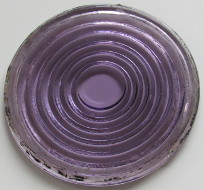 |
 |
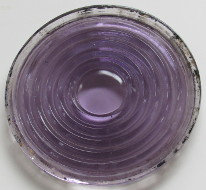 |
| Top view |
Closeup of prisms and bull's-eye center |
Bottom view |
|
Hexagonal Pyramid aka
"Pointed" or "Spike"
|
Pyramids usually in two nominal sizes, 3" and 4" (measured across
the flats), although Thomas Laughlin Co. lists them in 3½" and
4½". This style has been reproduced in vast numbers, mostly
copying the lone surviving original prism
on the 1840s whaler Charles W. Morgan,
now at Mystic Seaport Museum.
My originals (shown below) all have sharp base edges and are somewhat
crude, unlike the modern reproductions which have smooth, rounded base
edges and are of uniformly higher production quality. Reproductions
come in many beautiful but unauthentic colors which would be useless
for anything except mood lighting.
|
 |
 |
| 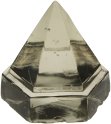 |
 |
| 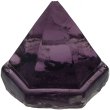 |
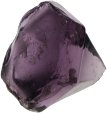 |
|
W: 3 1/8";
H: 3½";
B: 1 1/8" |
W: 3 1/8";
H: 3½";
B: 1" |
W: 3 1/8";
H: ~3¼";
B: ¾" |
 |
 |
 |
| Bezel: 14¼" × 6½" × 1½";
prisms 3 7/8" across the flats × 4" high |
 |
 |
 |
|
Bezel: About 57/8" across the flats ×
1½" deep; prism 37/8" across the
flats × about 4¼" hiigh
|
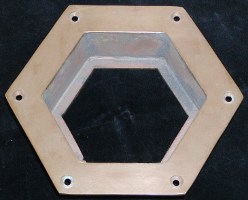 |
 |
Bezel: Outside: 6½" across the flats × 1¾" deep
Inside: 4½" × 19/16" deep
New Old Stock.
|
|
Reamer aka "Melon"
|
This style prism looks like an orange juicer, aka reamer,
but is styled "melon" by its makers. I don't know the design's
origins; it's not shown in any of my catalogs, nor do I know of a
patent which covers it. My larger example has a yellow tint
that looks to be caused by selenium, the decolorizer which replaced
manganese around WWI. Like manganese, which turns pink/purple after
prolonged UV exposure (solarizing), selenium also changes color,
turning "straw", a light yellow. Selenium was used mainly post-war,
around 1920-1930, with usage tapering off by mid-century.
The Mother of All Reamers below is 7¾" in diameter, 5"
high and weights 10¼#. This is much larger than the
typical units which are 3 - 4" in diameter. It was reported to have
been retrieved from the bottom of the Baltic. Is it Russian? There
are no markings.
Reamers in a variety of sizes and depths are still made today by
Davey & Company but nobody is
making them this large.
|
|
This purple reamer is about the same height, but 6¼" in
diameter and 5½# (without the original bronze bezel), which is
still large for this style, but much smaller than the Mother. It has no
provenance and no markings. Because of its purple color, we can assume
it's pre-WWI.
|
Size comparison:
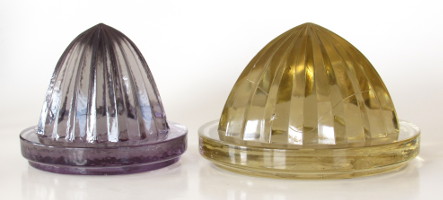
Melon variant with bull's-eye (6" wide, 5" tall).
Photos: humbleseabird (eBay)


 |


 |
| Typical design, still made today |
Unusual step-pyramid pattern |
|
Ribbed or Reeded
|
| This style appears in three of my early marine
hardware catalogs (Durkee,
Laughlin and
Tiebout) dating from
1915 to 1920.
They all list the same set of sizes, 6"×3",
9½"×2½", 10"×3",
10½"×3½" and 12"×4", and the illustrations
are very similar. Were they all selling the same manufacturer's
products?
I haven't seen any original examples in situ, but Capt. Dan
Berg recovered the one at right from the wreck of the
Cornelia Soule,
a three-master schooner which ran aground in 1902.
|
| 
Capt. Dan Berg holding reeded deck light from the wreck of the
Cornelia Soule.
|

Durkee

Laughlin |

Tiebout |
|